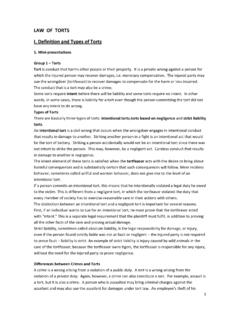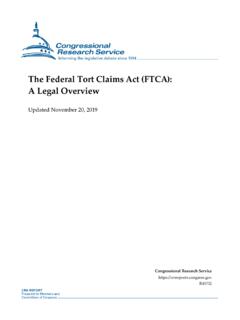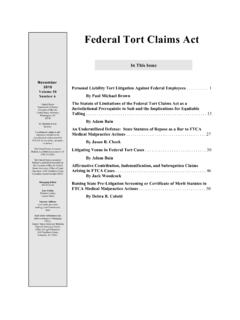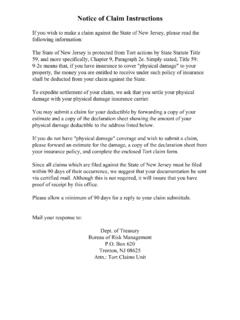Transcription of THE FIVE ELEMENTS OF NEGLIGENCE - Hofstra Law Home Page
1 11/14/2007 2:25:46 PM 1671 Volume 35, No. 4 Summer 2007 THE FIVE ELEMENTS OF NEGLIGENCE David G. Owen* After centuries of glacial development in the English forms of action, NEGLIGENCE law in America began to take shape during the 1830s and 1840s as a general theory of liability for carelessly caused harm. Conveniently (if roughly) dated to Chief Judge Shaw s 1850 decision in Brown v. Kendall,1 NEGLIGENCE emerged as a distinct tort sometime during the middle of the nineteenth The essence of the tort was that a person should be subject to liability for carelessly causing harm to Also essential to NEGLIGENCE , evident from an early date, was the necessity of a causal connection between the defendant s breach of duty and the plaintiff s damage that was natural, probable, proximate, and not too As early courts and commentators explored the developing tort of NEGLIGENCE , they increasingly divided it into its essential pieces ELEMENTS centered on a defendant s failure to exercise due care and * Carolina Distinguished Professor of Law, University of South Carolina.
2 Thanks to Aaron Twerski for originating the idea of Ideas, of which this is one, and to Karen Miller for research and editorial assistance. 1. 60 Mass. (6 Cush.) 292 (1850). 2. See Percy H. Winfield, The History of NEGLIGENCE in the Law of tort , 42 REV. 184, 195-96 (1926). 3. See, , JAMES HENRY DEERING, THE LAW OF NEGLIGENCE 1 (1886). 4. See, , DEERING, supra note 3, 1, at 27 (citing FRANCIS WHARTON, LAW OF NEGLIGENCE 3 (1874)); WILLIAM B. HALE, HANDBOOK ON THE LAW OF TORTS 19, at 44 (1896). 11/14/2007 2:25:46 PM 1672 Hofstra LAW REVIEW [Vol. 35:1671 the plaintiff s proximately resulting As NEGLIGENCE law proceeded to evolve, its ELEMENTS were stated in a variety of ways, but most courts6 and commentators7 in time came to assert that it contains four ELEMENTS .]
3 In perhaps its most conventional current iteration, NEGLIGENCE is formulated in terms of duty, breach, cause, and Yet, courts and commentators continue to disagree on what the four ELEMENTS should contain, on just how the various ideas recognized as essential to NEGLIGENCE claims should be stuffed into the four Many courts frame the law of NEGLIGENCE within three ELEMENTS duty, breach, and proximately caused And at least one court has reduced the 5. See, , H. GERALD CHAPIN, HANDBOOK ON THE LAW OF TORTS 105, at 501 (1917) ((1) duty, (2) breach, and (3) resulting injury); HALE, supra note 4, 227, at 449 (1896) ( The essential ELEMENTS of actionable NEGLIGENCE are: (a) Failure to exercise commensurate care, involving (b) A breach of duty, resulting proximately in (c) Damage to plaintiff.)
4 6. Our review of recent supreme court decisions reveals four ELEMENTS (sometimes listed without enumeration) in Alabama, Alaska, Arizona, Arkansas, Colorado, Connecticut, Florida, Georgia, Hawaii, Idaho, Iowa, Maine, Maryland, Massachusetts, Michigan, Minnesota, Mississippi, Montana, Nebraska, Nevada, Pennsylvania, Rhode Island, South Carolina, South Dakota, Utah, Washington, West Virginia, Wisconsin, and Wyoming, for a total of nearly thirty current four-element states. 7. See, , KENNETH S. ABRAHAM, THE FORMS AND FUNCTIONS OF tort LAW 46 (2d ed. 2002); RICHARD A. EPSTEIN, TORTS , at 109 (1999); W. PAGE KEETON, DAN B. DOBBS, ROBERT E. KEETON & DAVID G. OWEN, PROSSER AND KEETON ON THE LAW OF TORTS 30, at 164 (5th ed. 1984); John Goldberg & Benjamin C. Zipursky, The Restatement (Third) and the Place of Duty in NEGLIGENCE Law, 54 VAND.
5 L. REV. 657, 658 (2001). 8. See, , Winn v. Posades, 913 407, 411 (Conn. 2007); Durham v. HTH Corp., 870 577, 579 (Me. 2005); Brown v. Brown, 739 313 (Mich. 2007); Paz v. Brush Engineered Materials, Inc., 949 So. 2d 1, 3 (Miss. 2007); Barr v. Great Falls Int l Airport Auth., 107 471, 477 (Mont. 2005); Avery v. Diedrich, 734 159, 164 (Wis. 2007). 9. See, , Raleigh v. Performance Plumbing & Heating, Inc., 130 1011, 1015 (Colo. 2006) ( (1) the existence of a legal duty to the plaintiff; (2) the defendant breached that duty; (3) the plaintiff was injured; and (4) the defendant s breach of duty caused the injury ) (citations omitted); Bhakta v. County of Maui, 124 943, 956 (Haw. 2005) ((1) duty; (2) breach; (3) a reasonably close causal connection between the conduct and the resulting injury; and (4) damage); State Farm Fire & Cas. v. Aquila Inc., 718 879, 887 (Minn.)
6 2006) ((1) a duty of care; (2) breach; (3) injury; and (4) breach as the proximate cause of the injury); Farabaugh v. Pa. Turnpike Comm n, 911 1264, 1272-73 (Pa. 2006) ( (1) a duty of care; (2) the breach of the duty; (3) a causal connection between the conduct and the resulting injury; and (4) actual loss or damage resulting to the plaintiff ); Jenkins v. CSX Transp., Inc., 649 294, 302 (W. Va. 2007) ( duty, breach, foreseeability, and causation ) (citation omitted). A minority of four-element states modify the causation element with proximate or legal. See, , Jones Food Co. v. Shipman, No. 1051322, 2006 WL 3718254, at *5 (Ala. 2006) ( proximate ); Jordan v. State ex rel. Dep t of Motor Vehicles & Pub. Safety, 110 30, 51 (Nev. 2005) ( legal ). 10. Nearly twenty jurisdictions organize NEGLIGENCE in a three-element construct.
7 See, , Ford Motor Co. v. Rushford, 868 806, 810 (Ind. 2007) ( To prevail on a claim of NEGLIGENCE , a plaintiff is required to prove: (1) a duty owed by the defendant to the plaintiff; (2) a breach of that duty by the defendant; and (3) an injury to the plaintiff proximately caused by the 11/14/2007 2:25:46 PM 2007] THE FIVE ELEMENTS OF NEGLIGENCE 1673 element count to More completely, two courts,12 some commentators,13 and the Restatement (Third) of Torts14 attribute element status to five essential aspects of NEGLIGENCE , the standard four above plus proximate cause. My thesis here is that the latter, five-element formulation is best.)
8 This is because each of the five components is complex and conceptually distinct, and because all must coexist or a NEGLIGENCE claim will fail. Disputes over how the ELEMENTS of NEGLIGENCE should be formulated arise every generation or so when the American Law Institute restates the law of torts, which is what it is doing Normally, most courts and commentators have other (arguably more important) fish to fry and little interest in trifling with how one element or another should be conceived or phrased. Yet the outline of a tort structures how lawyers frame specific issues, which affects how scholars conceive and critique the law and how judges apply it to cases they decide. Thus, how the components of NEGLIGENCE are formulated is important to an elemental understanding of the nature of this tort and how it properly should be applied.
9 The standard four-element account of NEGLIGENCE as duty, breach, cause, and damage misleadingly conflates two distinct ideas that too often are linked uncomfortably together under the umbrella term, breach. ) (citation omitted); Stein v. Asheville City Bd. of Educ., 626 263, 267 ( 2006) ( (1) a legal duty; (2) a breach thereof; and (3) injury proximately caused by the breach ). 11. White v. Mattera, 814 627, 631 ( 2003) ( [T]here are two essential ELEMENTS of a cause of action based on the alleged NEGLIGENCE of a tortfeasor which must exist .. , namely, the act of NEGLIGENCE itself and a consequential injury resulting therefrom. ) (citations omitted). 12. See Detraz v. Lee, 950 So. 2d 557, 562 (La. 2007) ((1) duty; (2) breach; (3) cause-in-fact; (4) legal cause; and (5) damages); Naifeh v. Valley Forge Life Ins.
10 Co., 204 758, 771 (Tenn. 2006) ((1) duty; (2) breach; (3) injury; (4) causation in fact; and (5) proximate, or legal, cause ) (citation omitted). 13. See, , DAN B. DOBBS, THE LAW OF TORTS 114, at 269 (2000); THOMAS C. GALLIGAN, PHOEBE A. HADDON, FRANK L. MARAIST, FRANK MCCLELLAN, MICHAEL L. RUSTAD, NICOLAS P. TERRY & STEPHANIE M. WILDMAN, tort LAW: CASES, PERSPECTIVES, AND PROBLEMS 167 (4th ed. 2007). 14. See infra note 15. 15. In 1996, the American Law Institute commissioned a Restatement (Third) of Torts: General Principles, eventually renamed the Restatement (Third) of Torts: Liability for Physical and Emotional Harm, that now is close to completion. The Third Restatement s most recent draft of the section on NEGLIGENCE liability states the five ELEMENTS of a prima facie case for NEGLIGENCE as duty, failure to exercise reasonable care, factual cause, physical harm, and harm within the scope of liability (which historically has been called proximate cause ).








